
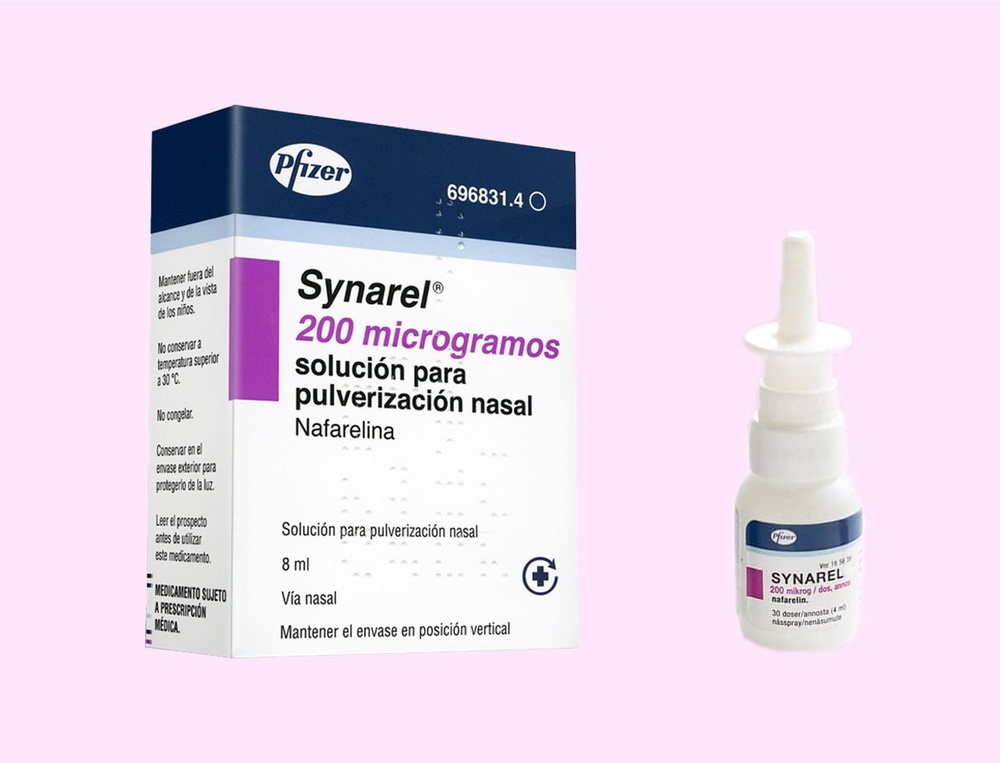
SYNAREL 200 microgramas SOLUÇÃO PARA PULVERIZAÇÃO NASAL


Como usar SYNAREL 200 microgramas SOLUÇÃO PARA PULVERIZAÇÃO NASAL
Introdução
Prospecto: informação para o utilizador
SYNAREL200 microgramas solução para pulverização nasal
Nafarelina
Leia todo o prospecto detenidamente antes de começar a usar este medicamento,porque contém informações importantes para si.
- Conserva este prospecto, porque pode ter que voltar a lê-lo.
- Se tiver alguma dúvida, consulte o seu médico ou farmacêutico.
- Este medicamento foi-lhe prescrito somente a si, e não deve dá-lo a outras pessoas, mesmo que tenham os mesmos sintomas que si, porque pode prejudicá-las.
- Se experimentar efeitos adversos, consulte o seu médico ou farmacêutico, mesmo que se trate de efeitos adversos que não aparecem neste prospecto. Ver secção 4.
Conteúdo do prospecto:
- O que é Synarel e para que é utilizado
- O que necessita saber antes de começar a usar Synarel
- Como usar Synarel
- Posíveis efeitos adversos
- Conservação de Synarel
Conteúdo do envase e informação adicional
1. O que é Synarel e para que é utilizado
Synarel pertence a uma classe de medicamentos denominados análogos sintéticos da hormona liberadora de gonadotropinas (substância natural fabricada pelo organismo que estimula os ovários da mulher - que são os órgãos que contêm os óvulos - e os testículos do homem). Actua diminuindo a resposta normal do seu organismo a esta hormona, e como resultado, os ovários produzem menor quantidade de outras hormonas chamadas estrógenos. Si notará esta diminuição porque a sua menstruação se interromperá ou diminuirá em quantidade após aproximadamente um mês de usar este medicamento.
Synarel é utilizado em:
- Endometriose (localização anormal da membrana que reveste o útero), incluindo o alívio dos sintomas que a acompanham, como por exemplo: menstruação dolorosa, coito doloroso, dor pélvica geral e perdas de sangue importantes durante a menstruação.
- Programas de estimulação controlada dos ovários antes de realizar a fertilização in vitro, sempre sob a supervisão de um médico especialista.
2. O que necessita saber antes de começar a usar Synarel
Não use Synarel
- Se é alérgico a nafarelina, à hormona liberadora de gonadotropinas natural, a outros medicamentos análogos da hormona liberadora de gonadotropinas ou a qualquer um dos outros componentes deste medicamento (incluídos na secção 6).
- Se sofre sangrados vaginais e a causa não está determinada.
- Se está grávida ou está a pensar ficar grávida durante o tratamento. Se está a utilizar este medicamento como parte de um programa de fertilização “in vitro”, a sua gravidez estará prevista para quando finalizar o tratamento (ver apartado “Gravidez e lactação”).
- Se está a amamentar.
- Se já usou Synarel durante seis meses (ver apartado “Posíveis efeitos adversos”).
Advertências e precauções
Consulte o seu médico ou farmacêutico antes de começar a tomar este medicamento
- Se si esqueceu de tomar uma ou várias doses, porque isso suporia um risco de ficar grávida.
- Recomenda-se a utilização de métodos anticonceptivos de barreira não hormonais (diafragma, dispositivos intrauterinos (DIU), preservativos) enquanto se encontra a tomar este medicamento, para evitar ficar grávida (ver apartado “Gravidez e lactação”).
- Se si apresenta antecedentes de quistes múltiplos nos ovários, pois estes poderiam aumentar de número ou tamanho. Embora estes geralmente desapareçam espontaneamente às 4-6 semanas de tratamento, em alguns casos pode ser necessária a interrupção do mesmo e/ou a intervenção cirúrgica.
- Se si tem antecedentes familiares de osteoporose (doença pela qual os ossos se debilitam, podendo aparecer dor e incrementando-se o risco de fracturas dos mesmos), pois durante o tratamento pode produzir-se uma pequena perda do mineral dos ossos (ver apartado “Posíveis efeitos adversos”).
- Se a menstruação não se reduzir após 2 meses de tratamento. Informe o seu médico, porque durante o tratamento com Synarel, a menstruação deveria interromper-se ou diminuir em quantidade. Assim como, se às 4-8 semanas após interromper o tratamento com Synarel não voltar a ter a menstruação normal, consulte o seu médico.
- Se si precisa usar um descongestionante nasal, nesse caso, o descongestionante deverá ser usado pelo menos 30 minutos após ter usado Synarel (ver apartado “Uso de outros medicamentos”).
- Se si precisa realizar exames de exploração do eixo hipófiso-gonadal, posto que os resultados poderão ser alterados até 8 semanas após finalizar o tratamento.
- Se após um período de tratamento, tiver que se submeter a um retratamento, o seu médico deverá determinar a densidade mineral óssea antes de começar a usar novamente o medicamento.
- Foram notificados casos de depressão em pacientes que tomam Synarel que pode ser grave. Se si está tomando Synarel e apresenta depressão, informe o seu médico.
- O uso de Synarel em combinação com gonadotropina para tratar a infertilidade pode produzir às vezes uma reação exagerada nos ovários (síndrome de hiperestimulação ovárica, SHO). Pode notar dor de estômago, inchação de estômago e malestar ou náuseas. Se isso acontecer, consulte com o seu médico. Ver também a secção 4 “Posíveis efeitos adversos”.
Crianças e adolescentes
Desaconselha-se o uso de Synarel em pessoas menores de 18 anos.
Outros medicamentos e Synarel
Informa o seu médico ou farmacêutico se está a utilizar ou utilizou recentemente ou pudesse ter que tomar outros medicamentos, mesmo os adquiridos sem receita.
Não é de esperar que Synarel apresente interações com outros medicamentos.
Os descongestionantes nasais diminuem a absorção de Synarel, por isso não deverá usar este tipo de medicamentos nos 30 minutos seguintes à administração de Synarel. No entanto, a rinite (inflamação da mucosa interna do nariz devida a alergia ou a um resfriado, e que pode tapar-lhe o nariz) não parece modificar a absorção de Synarel, com o que pode continuar a utilizá-lo de forma normal (ver apartado “Como usar Synarel”).
Gravidez e lactação
Se está grávida ou em período de lactação, acredita que possa estar grávida ou tem intenção de ficar grávida, consulte o seu médico ou farmacêutico antes de utilizar este medicamento.
Antes de iniciar o tratamento com Synarel deverá confirmar-se que si não está grávida. Não deve utilizar Synarel se está grávida ou suspeita que possa estar.
Durante o tratamento deve evitar ficar grávida utilizando métodos anticonceptivos de barreira não hormonais, tais como o diafragma, DIU, preservativos, mas NÃO anticonceptivos orais, porque é um método hormonal. Isto pode parecer-lhe estranho se está a tomar Synarel como parte de um programa de fertilização in vitro, mas isto é assim porque a sua gravidez estará prevista para quando finalizar o tratamento e não deve produzir-se antes. Em caso de que si fique grávida durante o mesmo, deverá interromper o tratamento e comunicá-lo ao seu médico, que o informará com mais detalhe sobre este tema.
Este medicamento não deve ser administrado durante o período de lactação.
Condução e uso de máquinas
A influência sobre a capacidade de conduzir e utilizar máquinas é nula ou insignificante.
Synarel contém cloreto de benzalconio.
Este medicamento contém 0,01 mg de cloreto de benzalconio em cada pulverização.
O cloreto de benzalconio pode causar irritação ou inflamação dentro do nariz, especialmente quando se usa durante um tratamento a longo prazo.
3. Como usar Synarel
Somente poderão utilizar Synarel aquelas mulheres com uma idade igual ou superior a 18 anos, porque a experiência clínica se limita a essas idades.
Siga exatamente as instruções de administração deste medicamento indicadas pelo seu médico.
O tratamento com Synarel será realizado sob o controlo e as recomendações do seu médico, e requer o controlo periódico por este. O seu médico indicar-lhe-á a duração do seu tratamento com Synarel. Não suspenda o tratamento antes.
Lembre-se de usar o seu medicamento.
Synarel deve ser administrado unicamente por via nasal. Como norma geral, a dose do medicamento e a frequência de administração é a seguinte:
- Endometriose:o tratamento deve iniciar-se entre o dia 2 e o dia 4 do ciclo menstrual. A dose recomendada é de 2 pulverizações por dia (400 microgramas), divididas em duas administrações (uma pulverização em um orifício nasal pela manhã e outra pulverização no outro orifício nasal à noite). Em alguns casos, poderia ser necessário aumentar a dose para 4 pulverizações por dia (800 microgramas); neste caso, serão administradas duas pulverizações pela manhã (uma em cada fosa nasal) e outras duas à noite (uma em cada fosa nasal). O seu médico indicar-lhe-á qual é a dose recomendada para si.
A duração máxima recomendada do tratamento é de 6 meses.
- Estimulação controlada dos ovários:se está a tomar este medicamento como parte de um programa de fertilização in vitro, o seu médico indicar-lhe-á quando deve iniciar o tratamento. A dose recomendada é de 4 pulverizações por dia (800 microgramas), ou seja, uma pulverização em ambos os orifícios nasais pela manhã e outra pulverização em ambos os orifícios nasais à noite. O seu médico pode decidir retirar-lhe o tratamento se não observar uma resposta ao mesmo.
Normalmente, o período de tratamento não supera as 8 semanas.
Conselhos importantes sobre o uso de Synarel
- A bomba deve produzir uma pulverização fina, que só pode ocorrer mediante uma ação de bombeamento rápida e firme. É normal ver algumas gotas de líquido maiores dentro do pulverizado. No entanto, se Synarel sai da bomba como um jato em vez de uma pulverização fina, Synarel pode não funcionar bem, e deve consultar com o seu farmacêutico.
- Certifique-se de limpar o extremo do pulverizador antes e após cada uso. Se não o fizer, pode que se obstrua o extremo do pulverizador e que não se libere a quantidade correcta prescrita. Sempre coloque o fecho de segurança e o tampão de plástico no extremo do pulverizador após o seu uso para evitar que se obstrua.
- A bomba está fabricada para administrar somente uma quantidade determinada de medicamento, sem importar a força com que se prima a bomba.
- Não tente aumentar o orifício do extremo do pulverizador. Se o orifício for aumentado, a bomba liberará uma dose incorrecta de Synarel.
Antes da primeira utilização devem seguir-se estas instruções:
Antes da primeira utilização de cada frasco de SYNAREL, é necessário carregar a bomba. Este passo só tem que ser realizado uma vez, antes de que vá a utilizar este medicamento pela primeira vez.
- Retire e guarde o fecho de segurança e o tampão para deixar ao descoberto o pulverizador nasal. Segure o frasco em posição vertical colocando 2 dedos nos salientes da bomba, e o polegar na base do frasco.
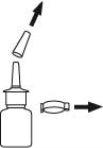
- Carregue a bomba primindo com o polegar para cima várias vezes firmemente e rapidamente até que saia o ar e apareça uma pulverização fina. Isto requer de 5 a 7 pressões, mantendo o envase com o extremo superior afastado de si. Não é necessário repetir esta operação com o uso posterior do medicamento, porque se desperdiçaria o medicamento.

- Limpe a boquilla de pulverização após a sua utilização:
Mantenha a garrafa em posição horizontal e enxágue a boquilla de pulverização com água morna enquanto a limpa com os dedos ou um pano limpo durante 15 segundos.
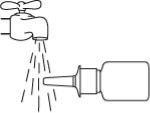
Não limpe o extremo do pulverizador com um objeto pontiagudo.Isto pode causar que se libere uma quantidade incorrecta. Não separe a bomba do frasco, porque isto liberará a pressão de pulverização.
Seque o extremo do pulverizador com um pano suave e limpo ou com um lenço de papel.
Utilização do pulverizador:
- Assoe o nariz suavemente para limpar os seus orifícios nasais.


- Retire e guarde o fecho de segurança e o tampão do envase para deixar ao descoberto o pulverizador nasal. Segure o frasco tal como se mostrou previamente.
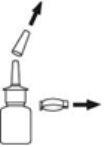
- Limpe o extremo do pulverizador nasal. Para isso, segure o frasco em posição horizontal e enxágue o extremo do pulverizador com água morna limpa com o dedo ou com um pano suave durante 15 segundos.
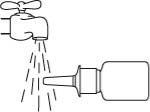
Não limpe o extremo do pulverizador com um objeto pontiagudo. Isto pode causar que se libere uma quantidade incorrecta. Não separe a bomba do frasco, porque isto liberará a pressão de pulverização.
Seque o extremo do pulverizador com um pano suave e limpo ou com um lenço de papel.
- Incline ligeiramente a cabeça para a frente. Introduza o extremo do pulverizador num orifício nasal, dirigindo-o para a parte posteriore externado nariz. Feche o outro orifício nasal com o dedo.
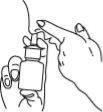
- Prima o pulverizador de forma rápida e firme uma só vez, e inspire suavemente ao mesmo tempo.
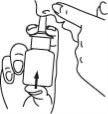
- Retire o pulverizador do nariz e incline a cabeça para trás durante alguns segundos para que o líquido passe para a parte posterior do nariz.

- Limpe o extremo do pulverizador nasal. Para isso, segure o frasco em posição horizontal e enxágue o extremo do pulverizador com água morna limpa com o dedo ou com um pano suave durante 15 segundos.
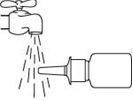
Não limpeo extremo do pulverizadorcom um objeto pontiagudo.Isto pode causar que se libere uma quantidade incorrecta. Não separe a bomba do frasco, porque isto liberará a pressão.
Seque o extremo do pulverizador com um pano suave e limpo ou com um lenço de papel.
Limpe o extremo do pulverizador antes e após cada uso para evitar que se obstrua o pulverizador, porque se obstruir, poderia liberar-se uma quantidade incorrecta de medicamento.
- Coloque a tampa e o fecho de segurança do envase para cobrir o extremo do pulverizador. Isto é importante para evitar que o extremo do pulverizador se obstrua.
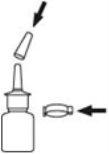
Consulte o seu médico ou farmacêutico se tiver dúvidas sobre estas instruções.
É importante que si utilize regularmente este medicamento seguindo as doses recomendadas, diariamente, pela manhã e à noite (ver apartado “Se esqueceu de utilizar Synarel”).
Não deve interromper o tratamento se sofrer um resfriado comum. Se desejar utilizar um descongestionante nasal, recomenda-se a sua administração pelo menos 30 minutos após ter utilizado Synarel (ver apartado “Uso de outros medicamentos”).
Se si estornuda enquanto está a utilizar este medicamento ou após o ter feito, aconselha-se que repita a administração. No entanto, se estornuda sempre que utiliza Synarel, comunique-o ao seu médico.
Com o fim de assegurar uma administração adequada das doses, o frasco não deve ser utilizado mais de 30 dias (2 pulverizações por dia) ou de 15 dias (4 pulverizações por dia); findos estes, observará que resta uma pequena quantidade de solução no envase, mas não deve utilizá-la.
Se estima que a acção de Synarel é demasiado forte ou débil, comunique-o ao seu médico ou farmacêutico.
Se usar mais Synarel do que deve, consulte imediatamente o seu médico ou farmacêutico.
Em caso de sobredosagem ou ingestão acidental, consulte o Serviço de Informação Toxicológica. Telefone 91-562 04 20.
Se esqueceu de usar Synarel:
Deve utilizar este medicamento de forma habitual. Se esqueceu de o utilizar no momento necessário, faça-o assim que o lembrar, após o que voltará a utilizá-lo segundo se lhe indicou, ou seja, pela manhã e à noite.
Em caso de que si esqueceu de administrar-se uma dose, poderia sofrer sangrado vaginal. Se são várias as doses que não se administraram, si pode ficar grávida. Se isso acontecer, deverá interromper a administração deste medicamento e comunicá-lo ao seu médico imediatamente.
Não tome uma dose dupla para compensar as doses esquecidas.
4. Possíveis efeitos adversos
Tal como todos os medicamentos, o Synarel pode ter efeitos adversos, embora nem todas as pessoas os sofram. A frequência estimada de ocorrência dos mesmos em adultos é a seguinte:
Os efeitos adversos muito frequentes (pelo menos 1 de cada 10 doentes) são:
- Aumento de peso.
- Labilidade afetiva (mudanças de humor), diminuição da libido (desejo sexual).
- Cefaleia (dor de cabeça).
- Sofocos.
- Rinite (inflamação da mucosa nasal).
- Acne, seborreia (excesso de gordura na pele).
- Mialgia (dor muscular).
- Atrofia da mama, secura vulvovaginal, diminuição do tamanho da mama.
- Edema (inchaço).
Os efeitos adversos frequentes (pelo menos 1 de cada 100 doentes) são:
- Hipersensibilidade ao fármaco que se caracteriza por dor no peito, dispneia (dificuldade para respirar), prurido (coceira), erupção, urticária (lesões vermelhas elevadas na pele).
- Deficiência de estrógenos (hormonas sexuais femininas).
- Diminuição de peso.
- Depressão, insónia (dificuldade para dormir), aumento da libido (desejo sexual).
- Parestesia (sensação de formigamento).
- Hipertensão (elevação da pressão arterial), hipotensão (diminuição da pressão arterial).
- Irritação da mucosa nasal.
- Hirsutismo (crescimento excessivo de pelos).
- Artralgia (dor nas articulações).
- Menopausa artificial, hemorragia uterina (sangramento procedente do útero).
- Diminuição da densidade óssea (aumento da porosidade do osso).
Os efeitos adversos pouco frequentes (pelo menos 1 de cada 1.000 doentes) são:
- Alopecia (queda de cabelo).
- Aumento do tamanho da mama, quistes ováricos (concentração de fluidos dentro do ovário).
Os efeitos adversos raros (pelo menos 1 de cada 10.000 doentes) são:
- GOT, GPT e fosfatase alcalina séricas elevadas (elevação das enzimas hepáticas, indicadores do funcionamento do fígado).
Os efeitos adversos cuja frequência não é conhecida (não pode ser estimada a partir dos dados disponíveis) são:
- Enxaqueca (dores de cabeça).
- Visão borrada (deterioração da visão).
- Palpitações (percepção da atividade do coração).
- Síndrome de hiperestimulação ovárica (resposta exagerada à estimulação dos ovários que pode ocasionar distensão abdominal, náuseas e/ou vômitos e diarreia. Nas formas graves líquido no abdômen).
Outros efeitos adversos em crianças e adolescentes
Os efeitos adversos e sua frequência estimada de ocorrência na população pediátrica são os seguintes:
Os efeitos adversos muito frequentes (pelo menos 1 de cada 10 doentes) são:
- Aumento do tamanho da mama.
Os efeitos adversos frequentes (pelo menos 1 de cada 100 doentes) são:
- Hipersensibilidade ao fármaco que se caracteriza por dor no peito, dispneia (dificuldade para respirar), prurido (coceira), erupção, urticária (lesões vermelhas elevadas na pele).
- Labilidade afetiva (mudanças de humor).
- Sofocos.
- Rinite.
- Acne, hirsutismo (crescimento excessivo de pelos), seborreia (excesso de gordura na pele), odor corporal anormal.
Os efeitos adversos pouco frequentes (pelo menos 1 de cada 1.000 doentes) são:
- Sangramento vaginal, secreção vaginal (fluxo vaginal).
Os efeitos adversos cuja frequência não é conhecida (não pode ser estimada a partir dos dados disponíveis) são:
- Aumento transitório do pelo pubiano.
Durante os dois primeiros meses de tratamento podem ocorrer alguns sangramentos vaginais. Não se preocupe, isto é normal.
Pode ocorrer também uma pequena diminuição no mineral que contém os ossos, embora se recupere durante os 6 meses seguintes à interrupção do tratamento. Em caso de que tenha antecedentes familiares de osteoporose, pode aumentar a possibilidade de que sofra uma perda de mineral dos ossos durante o tratamento (ver apartado “Tenha especial cuidado com Synarel”).
A maioria desses efeitos não é grave, desaparece ao finalizar o tratamento e não supõe um motivo para a interrupção do mesmo.
Alguns doentes apresentaram sintomas que podem indicar alergia a este medicamento, como dificuldade para respirar, dor no peito, erupção, vermelhidão da pele e coceira. Em caso de ocorrência de algum desses sintomas, interrompa a medicação e consulte o seu médico.
Se considera que algum dos efeitos adversos que sofre é grave ou se apercebe de qualquer efeito adverso não mencionado neste prospecto, informe o seu médico ou farmacêutico.
Comunicação de efeitos adversos
Se experimenta qualquer tipo de efeito adverso, consulte o seu médico, farmacêutico ou enfermeiro, mesmo que se trate de possíveis efeitos adversos que não aparecem neste prospecto. Também pode comunicá-los diretamente através do Sistema Espanhol de Farmacovigilância de Medicamentos de Uso Humano: www.notificaram.es. Mediante a comunicação de efeitos adversos, você pode contribuir para proporcionar mais informações sobre a segurança deste medicamento.
5. Conservação de Synarel
Não conserve a temperatura superior a 30 ºC.
Mantenha o envase em posição vertical (de pé).
Não congele.
Conservar no envase exterior para protegê-lo da luz.
Quando não estiver utilizando este medicamento, mantenha colocado o tampão e o fecho de segurança.
Mantenha fora do alcance e da vista das crianças.
Não utilize Synarel após a data de validade que aparece no envase.
Cada envase de Synarel pode ser utilizado durante um máximo de 30 dias, podendo reduzir-se este tempo em função da posologia (ver apartado “Como usar Synarel”).
Os medicamentos não devem ser jogados pelos desgotos nem na lixeira. Deposite os envases e os medicamentos que não precisa no ponto SIGRE da farmácia. Em caso de dúvida, pergunte ao seu farmacêutico como se livrar dos envases e dos medicamentos que não precisa. Dessa forma, ajudará a proteger o meio ambiente.
6. Conteúdo do envase e informações adicionais
Composição de Synarel
- O princípio ativo é nafarelinha (como acetato). Cada pulverização libera 100 microlitros de solução aquosa que contém acetato de nafarelinha equivalente a 200 microgramas de nafarelinha base.
- Os demais componentes são: sorbitol (E-420), cloreto de benzalconio, ácido acético glacial e água purificada.
Aspecto do produto e conteúdo do envase
Synarel é apresentado em solução para pulverização nasal, cada envase contém um frasco de 8 ml de solução aquosa, provido de uma válvula dosificadora. Cada frasco contém 60 doses.
Titular da autorização de comercialização e responsável pela fabricação
Titular da autorização de comercialização:
Pfizer, S.L.
Avda. de Europa, 20-B
Parque Empresarial La Moraleja
28108 Alcobendas (Madrid)
Espanha
Responsável pela fabricação:
PFIZER SERVICE COMPANY BV
Hoge Wei 10 (Zaventem)
B-1930 – Bélgica
Data da última revisão deste prospecto: Janeiro 2022
A informação detalhada e atualizada deste medicamento está disponível na página Web da Agência Espanhola de Medicamentos e Produtos Sanitários (AEMPS) http://www.aemps.gob.es/

Quanto custa o SYNAREL 200 microgramas SOLUÇÃO PARA PULVERIZAÇÃO NASAL em Espanha em 2025?
O preço médio do SYNAREL 200 microgramas SOLUÇÃO PARA PULVERIZAÇÃO NASAL em dezembro de 2025 é de cerca de 122.05 EUR. Os valores podem variar consoante a região, a farmácia e a necessidade de receita. Confirme sempre com uma farmácia local ou fonte online para obter informações atualizadas.
- País de registo
- Preço médio em farmácia122.05 EUR
- Substância ativa
- Requer receita médicaSim
- Fabricante
- Esta informação é apenas para referência e não constitui aconselhamento médico. Consulte sempre um médico antes de tomar qualquer medicamento. A Oladoctor não se responsabiliza por decisões médicas baseadas neste conteúdo.
- Alternativas a SYNAREL 200 microgramas SOLUÇÃO PARA PULVERIZAÇÃO NASALForma farmacêutica: INJETÁVEL, 0,25 mg/0,5 mlSubstância ativa: ganirelixFabricante: Gp Pharm S.A.Requer receita médicaForma farmacêutica: INJETÁVEL, 0,25 mgSubstância ativa: cetrorelixFabricante: Intas Third Party Sales 2005 S.L.Requer receita médicaForma farmacêutica: INJETÁVEL, DesconhecidaSubstância ativa: cetrorelixFabricante: Merck Europe B.V.Requer receita médica
Médicos online para SYNAREL 200 microgramas SOLUÇÃO PARA PULVERIZAÇÃO NASAL
Avaliação de posologia, efeitos secundários, interações, contraindicações e renovação da receita de SYNAREL 200 microgramas SOLUÇÃO PARA PULVERIZAÇÃO NASAL – sujeita a avaliação médica e regras locais.





